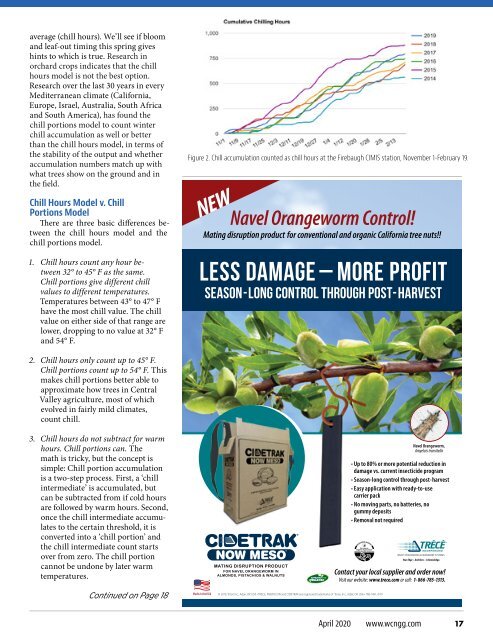You also want an ePaper? Increase the reach of your titles
YUMPU automatically turns print PDFs into web optimized ePapers that Google loves.
average (chill hours). We’ll see if bloom<br />
and leaf-out timing this spring gives<br />
hints to which is true. Research in<br />
orchard crops indicates that the chill<br />
hours model is not the best option.<br />
Research over the last 30 years in every<br />
Mediterranean climate (California,<br />
Europe, Israel, Australia, South Africa<br />
and South America), has found the<br />
chill portions model to count winter<br />
chill accumulation as well or better<br />
than the chill hours model, in terms of<br />
the stability of the output and whether<br />
accumulation numbers match up with<br />
what trees show on the ground and in<br />
the field.<br />
Chill Hours Model v. Chill<br />
Portions Model<br />
There are three basic differences between<br />
the chill hours model and the<br />
chill portions model.<br />
1. Chill hours count any hour between<br />
32° to 45° F as the same.<br />
Chill portions give different chill<br />
values to different temperatures.<br />
Temperatures between 43° to 47° F<br />
have the most chill value. The chill<br />
value on either side of that range are<br />
lower, dropping to no value at 32° F<br />
and 54° F.<br />
Figure 2. Chill accumulation counted as chill hours at the Firebaugh CIMIS station, November 1-February 19.<br />
Navel Orangeworm Control!<br />
Mating disruption product for conventional and organic California tree nuts!!<br />
LESS DAMAGE – MORE PROFIT<br />
SEASON-LONG CONTROL THROUGH POST-HARVEST<br />
2. Chill hours only count up to 45° F.<br />
Chill portions count up to 54° F. This<br />
makes chill portions better able to<br />
approximate how trees in Central<br />
Valley agriculture, most of which<br />
evolved in fairly mild climates,<br />
count chill.<br />
3. Chill hours do not subtract for warm<br />
hours. Chill portions can. The<br />
math is tricky, but the concept is<br />
simple: Chill portion accumulation<br />
is a two-step process. First, a ‘chill<br />
intermediate’ is accumulated, but<br />
can be subtracted from if cold hours<br />
are followed by warm hours. Second,<br />
once the chill intermediate accumulates<br />
to the certain threshold, it is<br />
converted into a ‘chill portion’ and<br />
the chill intermediate count starts<br />
over from zero. The chill portion<br />
cannot be undone by later warm<br />
temperatures.<br />
MATING DISRUPTION PRODUCT<br />
FOR NAVEL ORANGEWORM IN<br />
ALMONDS, PISTACHIOS & WALNUTS<br />
Navel Orangeworm,<br />
Amyelois transitella<br />
• Up to 80% or more potential reduction in<br />
damage vs. current insecticide program<br />
• Season-long control through post-harvest<br />
• Easy application with ready-to-use<br />
carrier pack<br />
• No moving parts, no batteries, no<br />
gummy deposits<br />
• Removal not required<br />
INCORPORAT ED<br />
INSECT PHEROMONE & KAIROMONE SYSTEMS<br />
Your Edge – And Ours – Is Knowledge.<br />
Contact your local supplier and order now!<br />
Visit our website: www.trece.com or call: 1- 866-785-1313.<br />
®<br />
Continued on Page 18<br />
© 2019, Trécé Inc., Adair, OK USA • TRECE, PHEROCON and CIDETRAK are registered trademarks of Trece, Inc., Adair, OK USA • TRE-1491, 4/19<br />
<strong>April</strong> <strong>2020</strong> www.wcngg.com 17


















